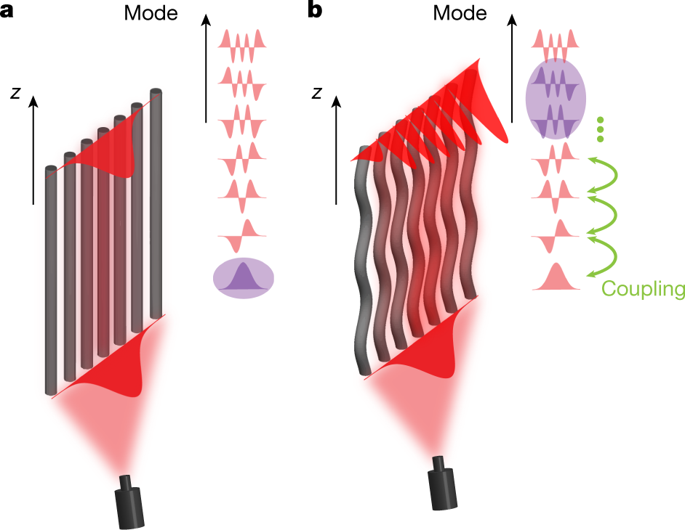Our official English website, www.x-mol.net, welcomes your
feedback! (Note: you will need to create a separate account there.)
Photonic topological insulator in synthetic dimensions
Nature ( IF 50.5 ) Pub Date : 2019-02-18 , DOI: 10.1038/s41586-019-0943-7 Eran Lustig , Steffen Weimann , Yonatan Plotnik , Yaakov Lumer , Miguel A. Bandres , Alexander Szameit , Mordechai Segev
Nature ( IF 50.5 ) Pub Date : 2019-02-18 , DOI: 10.1038/s41586-019-0943-7 Eran Lustig , Steffen Weimann , Yonatan Plotnik , Yaakov Lumer , Miguel A. Bandres , Alexander Szameit , Mordechai Segev

|
Topological phases enable protected transport along the edges of materials, offering immunity against scattering from disorder and imperfections. These phases have been demonstrated for electronic systems, electromagnetic waves1–5, cold atoms6,7, acoustics8 and even mechanics9, and their potential applications include spintronics, quantum computing and highly efficient lasers10–12. Typically, the model describing topological insulators is a spatial lattice in two or three dimensions. However, topological edge states have also been observed in a lattice with one spatial dimension and one synthetic dimension (corresponding to the spin modes of an ultracold atom13–15), and atomic modes have been used as synthetic dimensions to demonstrate lattice models and physical phenomena that are not accessible to experiments in spatial lattices13,16,17. In photonics, topological lattices with synthetic dimensions have been proposed for the study of physical phenomena in high dimensions and interacting photons18–22, but so far photonic topological insulators in synthetic dimensions have not been observed. Here we demonstrate experimentally a photonic topological insulator in synthetic dimensions. We fabricate a photonic lattice in which photons are subjected to an effective magnetic field in a space with one spatial dimension and one synthetic modal dimension. Our scheme supports topological edge states in this spatial-modal lattice, resulting in a robust topological state that extends over the bulk of a two-dimensional real-space lattice. Our system can be used to increase the dimensionality of a photonic lattice and induce long-range coupling by design, leading to lattice models that can be used to study unexplored physical phenomena.A spatially oscillating two-dimensional waveguide array is used to realize a photonic topological insulator in synthetic dimensions with modal-space edge states, unidirectionality and robust topological protection.
中文翻译:

合成维度的光子拓扑绝缘体
拓扑相能够保护材料边缘的传输,提供对无序和缺陷散射的免疫力。这些阶段已在电子系统、电磁波 1-5、冷原子 6、7、声学 8 甚至力学 9 中得到证明,它们的潜在应用包括自旋电子学、量子计算和高效激光器 10-12。通常,描述拓扑绝缘体的模型是二维或三维空间晶格。然而,在具有一个空间维度和一个合成维度(对应于超冷原子的自旋模式 13-15)的晶格中也观察到拓扑边缘态,并且原子模式已被用作合成维度来演示晶格模型和物理现象空间格子13,16,17中的实验无法访问。在光子学中,已经提出了具有合成维度的拓扑晶格来研究高维度和相互作用光子的物理现象 18-22,但到目前为止还没有观察到合成维度的光子拓扑绝缘体。在这里,我们通过实验证明了合成尺寸的光子拓扑绝缘体。我们制造了一个光子晶格,其中光子在具有一个空间维度和一个合成模态维度的空间中受到有效磁场的影响。我们的方案支持这个空间模态晶格中的拓扑边缘状态,从而产生一个健壮的拓扑状态,它延伸到二维实空间晶格的主体上。我们的系统可用于增加光子晶格的维数并通过设计诱导长程耦合,
更新日期:2019-02-18
中文翻译:

合成维度的光子拓扑绝缘体
拓扑相能够保护材料边缘的传输,提供对无序和缺陷散射的免疫力。这些阶段已在电子系统、电磁波 1-5、冷原子 6、7、声学 8 甚至力学 9 中得到证明,它们的潜在应用包括自旋电子学、量子计算和高效激光器 10-12。通常,描述拓扑绝缘体的模型是二维或三维空间晶格。然而,在具有一个空间维度和一个合成维度(对应于超冷原子的自旋模式 13-15)的晶格中也观察到拓扑边缘态,并且原子模式已被用作合成维度来演示晶格模型和物理现象空间格子13,16,17中的实验无法访问。在光子学中,已经提出了具有合成维度的拓扑晶格来研究高维度和相互作用光子的物理现象 18-22,但到目前为止还没有观察到合成维度的光子拓扑绝缘体。在这里,我们通过实验证明了合成尺寸的光子拓扑绝缘体。我们制造了一个光子晶格,其中光子在具有一个空间维度和一个合成模态维度的空间中受到有效磁场的影响。我们的方案支持这个空间模态晶格中的拓扑边缘状态,从而产生一个健壮的拓扑状态,它延伸到二维实空间晶格的主体上。我们的系统可用于增加光子晶格的维数并通过设计诱导长程耦合,















































 京公网安备 11010802027423号
京公网安备 11010802027423号